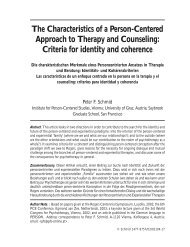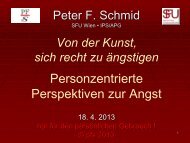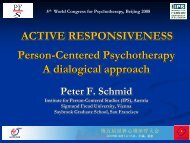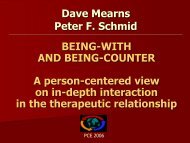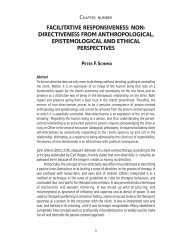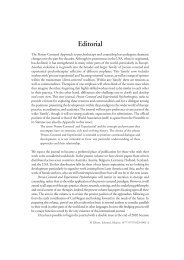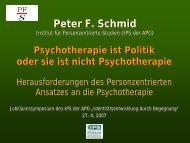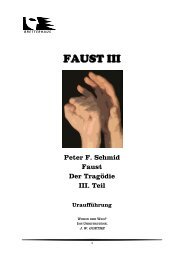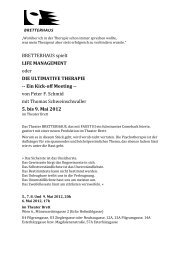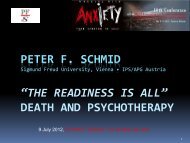authenticity and alienation - Peter F. Schmid
authenticity and alienation - Peter F. Schmid
authenticity and alienation - Peter F. Schmid
You also want an ePaper? Increase the reach of your titles
YUMPU automatically turns print PDFs into web optimized ePapers that Google loves.
AUTHENTICITY AND ALIENATION<br />
CHAPTER 6<br />
AUTHENTICITY AND ALIENATION:<br />
TOWARDS AN UNDERSTANDING OF THE<br />
PERSON BEYOND THE CATEGORIES OF<br />
ORDER AND DISORDER 1<br />
PETER F. SCHMID<br />
Don’t ask the doctor, ask the patient<br />
Jewish proverb<br />
If we take the Person-Centered Approach (PCA) seriously as a client-centered approach,<br />
we have to go back to our clients in order to engage them in an individualized, shared<br />
process of encounter <strong>and</strong> reflection. Following Rogers it is argued that the essential<br />
conditions of psychotherapy exist in a single configuration, even though they occur<br />
uniquely with each client. From a dialogical point of view, therapists <strong>and</strong> clients are not<br />
only seen as being in relationships; as persons they are relationships, which makes them<br />
different in each therapeutic contact. Furthermore, the traditional concepts of<br />
psychological health <strong>and</strong> disorder are rejected, seeing symptoms as a specific cry for help<br />
that has to be understood in a process of a personal encounter between therapist <strong>and</strong><br />
client. Following this concept it is appropriate to speak about clients as persons who are<br />
suffering from inauthentic or alienated forms of being in the world. The value of concepts<br />
<strong>and</strong> conceptions for helping us underst<strong>and</strong> different types of clients are acknowledged<br />
<strong>and</strong> emphasized. However, the existing concepts for, <strong>and</strong> descriptions of, our clients still<br />
exist only at a primitive, unsystematic stage of development <strong>and</strong> thus we need the<br />
development of a genuinely human science of Person-Centered Therapy.<br />
PERSONAL ANTHROPOLOGY: AUTHENTICITY AND<br />
ALIENATION<br />
Carl Rogers’ approach to mental health was humanistic, not medical. Taking the point<br />
of view of the social sciences, not the natural sciences, his holistic st<strong>and</strong>point on human<br />
beings encompassed not only the biological <strong>and</strong> individual nature but also the relational<br />
<strong>and</strong> social nature of the person. From the very outset, Rogers’ psychology was a social<br />
psychology (<strong>Schmid</strong>, 1994, 1996). In trying to underst<strong>and</strong> the human being within his<br />
1. Slightly revised version of a paper first printed in Person-Centered <strong>and</strong> Experiential Psychotherapies,<br />
3, (2004) 36–51.<br />
74
PETER F. SCHMID<br />
or her respective frame of reference Rogers came to view every individual as a unique<br />
being. Therefore, as opposed to an observational <strong>and</strong> analytical approach, he stood in<br />
the tradition of phenomenology, existentialism, hermeneutics <strong>and</strong> constructivism<br />
(Zurhorst, 1993).<br />
THE SUBSTANTIAL-RELATIONAL NOTION OF THE PERSON AS A SOCIAL CRITICISM<br />
But Rogers’ personality theory is not only a social psychological theory; it is also<br />
implicitly social criticism, a critical theory of socialization. Central to his underst<strong>and</strong>ing<br />
of the person is the process of <strong>authenticity</strong>, the perpetually striven for congruence<br />
between the ‘experiencing organism’ <strong>and</strong> the self concept. For a long time this was<br />
misunderstood individualistically, as referring only to isolated individuals. On the<br />
contrary, Rogers (1965: 20) clearly stated that the nature of the human being itself is<br />
‘incurably social’. From a personal, dialogical viewpoint we are not only in relationships;<br />
as persons we are relationships. Therefore the human person must be understood at<br />
one <strong>and</strong> the same time from both an individual or substantial view (which points to<br />
autonomy <strong>and</strong> sovereignty) <strong>and</strong> from a relational view (highlighting interconnectedness<br />
<strong>and</strong> solidarity) (<strong>Schmid</strong> 2001, 2002a, 2003). Self-determination <strong>and</strong> interrelatedness<br />
refer essentially to one <strong>and</strong> the same human nature; we only view <strong>and</strong> experience<br />
these as different dimensions. To regard the human as a substantial-relational being is<br />
what is meant by designating him/her as a person. Therefore any person-centered<br />
consideration on what ‘healthy’ or ‘fully functioning’ means, must include a theory of<br />
social criticism.<br />
‘PSYCHOLOGICAL HEALTH’: A THEORY OF AUTHENTICITY INSTEAD OF A ‘HEALTH’<br />
CONCEPT<br />
Authenticity as the process of balancing individuality <strong>and</strong> interrelatedness<br />
To be a person means to be truly called living the process of <strong>authenticity</strong>, developing<br />
one’s potential in a constructive way. To live authentically means to be able to keep<br />
the balance, or better, to gain always anew the synthesis between the substantial <strong>and</strong><br />
the relational task of living. A man or woman is authentic if they maintain this balance<br />
in the process of realizing their own values <strong>and</strong> needs, their individuality <strong>and</strong><br />
uniqueness, while at the same time living together with their others <strong>and</strong> the world,<br />
meeting the needs <strong>and</strong> challenges of these relationships in interdependence <strong>and</strong><br />
solidarity. Who is fully him-/herself is fully social, <strong>and</strong> vice versa. Self-realization <strong>and</strong><br />
solidarity coincide. This is how Rogers viewed what he called the ‘fully functioning<br />
person’. It was not by coincidence that Rogers referred to the biblical notion of ‘agape’,<br />
which embraces both dimensions: ‘You shall love your neighbor as yourself.’ (Leviticus<br />
19:18; Matthew 22: 39)<br />
From a superficial point of view, a person who lives this process of <strong>authenticity</strong> is<br />
called ‘healthy’ (etymologically connected with ‘whole’), ‘sane’ or even ‘normal’ or ‘in<br />
order’—whence the term ‘dis-order’ derives. This is in line with the meaning of ‘in-<br />
75
AUTHENTICITY AND ALIENATION<br />
firmity’ or ‘dis-ease’. But <strong>authenticity</strong> has nothing to do with being firm or at ease.<br />
These common terms are not only misleading, but completely wrong (see S<strong>and</strong>ers 2005,<br />
Chapter 3 this volume), because a severely ill person can live very authentically. This<br />
includes pain, fear, grief, struggle, sorrow, agony, transience, <strong>and</strong> stages of in<strong>authenticity</strong><br />
in which there is a new striving towards balance. It also means that each person is<br />
different in their way of being authentic.<br />
Rogers always thought about the fully functioning person in terms of the process of<br />
becoming, never about a state or an end product. The significant meaning of <strong>authenticity</strong><br />
is to live to become more <strong>and</strong> more authentic, that is, to become the author of one’s own<br />
life (<strong>Schmid</strong>, 2001).<br />
In summary: The image of the human being in person-centered anthropology differs<br />
qualitatively from the respective image in the natural sciences. It is human science, not natural<br />
science. Thus person-centered thinking sets out from a process theory of <strong>authenticity</strong>, not from<br />
a theory of failure or disorder. The person is understood as an existential process, a process of<br />
striving towards <strong>authenticity</strong> in every given moment of his/her existence, a joint process of<br />
self-development <strong>and</strong> relationship development. Therefore person-centered in itself is processcentered<br />
(which is clearly different from process-directive). In the view of a genuinely personal<br />
anthropology it makes no sense to separate the process from the person <strong>and</strong> it is impossible to<br />
separate content <strong>and</strong> process: in a very significant sense the process is the content is the meaning.<br />
(Therefore it also seems to be artificial to separate between relationship-, content- <strong>and</strong> processexperts.)<br />
ALIENATION: THE SUFFERING PERSON INSTEAD OF A CONCEPT OF ‘DIS-ORDERS’<br />
Trouble with the ongoing process of becoming authentic can be caused by the<br />
development of an inauthentic self-concept or by the lack of the development of some<br />
parts of the organismic experiencing capabilities (Spielhofer, 2003). In both cases,<br />
inauthentic or missing relationships play a crucial role, because a person becomes, <strong>and</strong><br />
is, the relationship they have, as stated above. A person becomes inauthentic, if they are<br />
alienated from self <strong>and</strong> Others, i.e., from the experiencing organism <strong>and</strong> the necessary<br />
genuine relationships. Psychological suffering is usually the result. Such a process must<br />
be understood as a fundamental self-contradictoriness (Selbstwidersprochenheit; Zurhorst,<br />
1993) between the capabilities <strong>and</strong> the natural process of experiencing, on the one<br />
h<strong>and</strong>, <strong>and</strong> the rigid <strong>and</strong> in itself torn structure of the self <strong>and</strong> resulting rigid relationships,<br />
on the other h<strong>and</strong>.<br />
In<strong>authenticity</strong> <strong>and</strong> maladjustment<br />
Consequently, for a critical theory of socialization, diagnosing <strong>and</strong> repairing a deviation<br />
from a norm is not an appropriate guideline. In trying to underst<strong>and</strong> how far a person<br />
is alienated from self, the prevailing <strong>and</strong> ruling cultural norm cannot be a constant,<br />
although it must be taken into account. This notion of ‘in<strong>authenticity</strong>’ differs qualitatively<br />
from the common meaning of illness or disorder. What is experienced from an internal<br />
76
PETER F. SCHMID<br />
frame of reference as ‘psychological suffering’, from an external point of view is seen as<br />
<strong>alienation</strong> or maladjustment. If it is called ‘disorder’, one must permanently keep in<br />
mind that the ‘order’ always is also a cultural norm.<br />
The ‘deviation’ can appear to be more on the substantial side, inasmuch as there<br />
are problems with a person’s individuality <strong>and</strong> being all wrapped up in the social roles,<br />
e.g., what is called melancholy, or it can look as if the difficulties are more relational,<br />
when a person refuses to engage in their social tasks, e.g., with schizophrenia (see Zurhorst,<br />
1993). No matter whether it is a deficit of substantial <strong>authenticity</strong> in the sense of ‘not<br />
being who you are’ or a deficit of relational <strong>authenticity</strong> in the sense of maladjustment,<br />
in either case the person is suffering. The ‘maladjusted person’ (see Rogers, 1959)—a<br />
term matching with the ‘fully functioning person’—who has not succeeded in gaining<br />
the authentic balance always suffers from both sides: they lack self-confidence due to an<br />
incongruence between self <strong>and</strong> experience (autonomy deficit) <strong>and</strong> lack trust in the world<br />
<strong>and</strong> others due to an incongruence between the others as perceived by the self <strong>and</strong> the<br />
others as really being Others (relationship deficit). So, suffering due to <strong>alienation</strong> is a<br />
signal of a deficiency or a loss of <strong>authenticity</strong>. A psychological symptom therefore is a<br />
cry for help. (<strong>Schmid</strong>, 1992)<br />
The symptom as a specific call for help to overcome in<strong>authenticity</strong><br />
The Greek word ‘symptom’ originally meant ‘coincidence, temporary peculiarity’; only<br />
later came to mean ‘sign, warning, distinguishing mark’; <strong>and</strong> finally took on the medical<br />
sense of a ‘characteristic sign of a specific disease’. A symptom is a phenomenon, something<br />
that is shown by the person. As everyone familiar with the psychiatric field knows,<br />
symptoms often appear to be accidental, they can be subject to fashion; e.g., think of<br />
co-morbidity <strong>and</strong> the intercorrelation of symptoms. One <strong>and</strong> the same client is quite<br />
often given a variety of diagnoses, frequently even contradictory ones.<br />
In the light of a philosophy of the person, a symptom is always a specific cry,<br />
coming out of the attempt to be seen <strong>and</strong> receive help. It is an expression of being<br />
severely out of balance in the process of striving for <strong>authenticity</strong> <strong>and</strong> the request for<br />
support, an attempt to deal with a situation by notifying oneself <strong>and</strong> others of the<br />
balance problem. In the specific cry lies the key to the underst<strong>and</strong>ing of the suffering<br />
person. It might often be a compromise between the problem <strong>and</strong> the request for help,<br />
but in any case it is, on psychological, mental, physical levels, a unique expression of this<br />
particular person in this particular situation, an expression of the wish to be understood<br />
<strong>and</strong> to underst<strong>and</strong> oneself. It is a call to others, to overcome the vicious circle <strong>and</strong> to get<br />
the process of authentic personalization restarted. Thus it always creates a unique situation<br />
of relationship. In this the key for therapy is to be found.<br />
Symptoms are as manifold as persons <strong>and</strong> situations are manifold. Many authors<br />
who regard differential treatment as necessary, reproach the Person-Centered Approach<br />
for adhering to a uniformity myth. What a gross misunderst<strong>and</strong>ing! According to<br />
personal anthropology, each suffering person is not viewed uniformly but is seen as<br />
entirely different. And so the therapeutic answer is: not uniform but unique (<strong>Schmid</strong>,<br />
1992).<br />
77
AUTHENTICITY AND ALIENATION<br />
In summary: Inauthentic persons are alienated from themselves <strong>and</strong> others. Suffering persons<br />
are communicating to themselves <strong>and</strong> others by symptoms that their process of striving towards<br />
<strong>authenticity</strong> in a given moment of their existence has severely failed or got stuck, that they<br />
need help in their processes of self <strong>and</strong> relationship development. Since the person is their<br />
existential process, the task is to underst<strong>and</strong> the particular process, which is the same as<br />
underst<strong>and</strong>ing the particular person. The challenge is not so much what has gone wrong, but<br />
where the possibilities are to facilitate the process of life, i.e., the self-healing capacities.<br />
THERAPY: PERSONALITY DEVELOPMENT THROUGH ENCOUNTER<br />
If it is correct that the reason for <strong>alienation</strong> <strong>and</strong> suffering is in<strong>authenticity</strong> <strong>and</strong> therefore<br />
relationship, then it is also relationship that helps. Aptly, the kind of relationship that<br />
can reconcile the alienated person with self <strong>and</strong> the world was called ‘encounter’ by<br />
Rogers (1962).<br />
Person-Centered Therapy is such a relationship: the facilitation of personalization<br />
(i.e., becoming a person) as a process of becoming independent <strong>and</strong> of co-creating<br />
relationships. Thus, therapy overcomes the stagnation (Pfeiffer, 1993). From a relational<br />
point of view, therapy is personal encounter; while from a substantial point of view it is<br />
personality development (which, by the way, sets the person-centered stance clearly<br />
apart from a merely systemic view as well as from other ahistoric therapies). That is,<br />
personalization occurs through encounter, personality development by working at<br />
relational depth (Mearns, 1996).<br />
Thus, although symptoms are manifold, the answer is always of the same kind: a<br />
certain relationship. Despite symptom specificity, the answer is a special kind of<br />
relationship. The same relational conditions that are crucial for the development of the<br />
infant <strong>and</strong> child are necessary <strong>and</strong> sufficient for psychotherapy. Psychotherapy is a special<br />
chapter of developmental psychology.<br />
Therefore the relationship is always the same <strong>and</strong> always different: the same, because<br />
it is always the presence (unfolded as the core conditions; <strong>Schmid</strong>, 2002b, 2003; Geller,<br />
<strong>Schmid</strong> <strong>and</strong> Wyatt, 2003) of the therapist that is needed <strong>and</strong> constitutes the answer to<br />
the cry expressed by symptoms. It is unique, because it is the special relationship of the<br />
persons involved at any given moment of the process that is needed, co-created in the<br />
encounter process.<br />
Does this mean ‘intervention homogeneity’ (Heinerth, 2002)? Yes <strong>and</strong> no. Yes,<br />
because therapy is independent of symptoms <strong>and</strong> circumstances, insofar as it is always<br />
the same ‘type’ of relationship that is needed: encounter. No, it is specific because two or<br />
more unique persons are involved in unique moments of encounter. Differentiated<br />
answers are necessary according to differential cries <strong>and</strong> different perspectives that the<br />
client expresses. They require differential empathy for the moment-by-moment process<br />
of the client’s self-exploration <strong>and</strong> the forms of relationships that are offered.<br />
In summary: Person-specific is not symptom-specific, or problem-specific (Mearns, 2003), or<br />
disorder-specific, <strong>and</strong> not at all disorder-oriented, but instead is uniquely process-specific.<br />
78
PETER F. SCHMID<br />
Consequently, disorder-oriented or goal-oriented is not person-oriented or process-oriented.<br />
Since it is the relationship that facilitates the process of personalization, differentiated<br />
relationships are needed: each person-to-person relationship is different, otherwise it would<br />
not be a personal relationship. But the kind of relationship is always the same: an encounter,<br />
although in very different ways. The client is seen as an active self healer ‘using’ the therapist<br />
for support in this ‘co-created interpersonal process’ (Bohart, 2003). As a part of the relationship,<br />
the therapist is different, if the client is different.<br />
PHENOMENOLOGICAL EPISTEMOLOGY: ACKNOWLEDGEMENT<br />
AND KNOWLEDGE<br />
If we were fully functioning persons we could always, with all persons <strong>and</strong> moment by<br />
moment, be the person the client needs in the given moment <strong>and</strong> provide the answers<br />
the client needs, thus creating the optimal relationship at any given instant. But we are<br />
not fully functioning persons, we are all more or less maladjusted persons. This raises<br />
the question, What we do ‘have’ that can be of help <strong>and</strong> that can allow us to enter<br />
encounter processes in difficult relationships, in spite of our being restricted by our own<br />
fears <strong>and</strong> security needs?<br />
The answer is: we have our ability to reflect. We have our intellect.<br />
THE RELEVANCE OF KNOWLEDGE AND CONCEPTIONS IN PCT<br />
Acknowledgment: the art of not-knowing<br />
In immediately encountering another person I do not think about what I could know<br />
about him/her; rather I am ready to accept what they are going to disclose. This is a<br />
change of epistemological paradigms of tremendous importance for psychotherapy. It<br />
expresses acknowledgement as an active <strong>and</strong> proactive way of deliberately saying yes<br />
to the Other as a person. Specifically, this portrays psychotherapy as the art of notknowing<br />
(<strong>Schmid</strong>, 2002a), the art of being curious, open to being surprised—a kind<br />
of sophisticated naïvety towards the client, where the challenging part is the unknown<br />
(see Takens, 2001) <strong>and</strong> not-yet-understood, the openness to wonderment, surprise<br />
<strong>and</strong> what the client has to disclose. ‘Each experience, which deserves this name, thwarts<br />
an expectation’ (Gadamer, 1999: 362). Thus back to the client! For a new, truly<br />
human image of the human being we need what Mearns (2003) calls a new<br />
epistemology.<br />
Reflection: the human capability of dealing with experience<br />
But life is not only surprise. We are able to think about our experiences <strong>and</strong> create<br />
expectations. We form specific concepts <strong>and</strong> theories. We inevitably do so <strong>and</strong> should<br />
be aware of this instead of ignoring it: we cheat ourselves if we think we do not think,<br />
expect <strong>and</strong> categorize. For a personal encounter relationship, both are necessary:<br />
acknowledgement <strong>and</strong> knowledge; experience <strong>and</strong> reflection.<br />
79
AUTHENTICITY AND ALIENATION<br />
Experiences lead to reflection. In order to be a personal encounter, therapy needs<br />
reflection both within <strong>and</strong> outside the therapeutic relationship. Reflection is necessary<br />
for a personal relationship not only after or outside therapy (e.g., in supervision, theory<br />
building or scientific work), reflection is also needed within the relationship, together<br />
with the client. A therapeutic encounter relationship is not only co-experiencing; it also<br />
is ‘co-thinking’ (Bohart, 2003). First, there is the immediate presence of persons, <strong>and</strong><br />
then there is the co-reflection by the involved persons about the meaning of their<br />
encounter experience. The experience needs a second view, a critical view from ‘outside’<br />
of the immediate encounter but within the relationship. The experience needs to be<br />
looked at, thus objectifying it. Only after this does the ‘initial encounter’ become a<br />
‘personal encounter’ relationship.<br />
As encounter philosophy has discerned, all en-counter processes start by being<br />
affected by the essence of the Other, of the unexpected as something or somebody<br />
that I experience as counter to me. Encounter means to face the other person, thus<br />
appreciating them as somebody independent, as an autonomous individual, different<br />
from me, <strong>and</strong> worthy of being dealt with (<strong>Schmid</strong>, 1994, 1998, 2002a). What at first<br />
is always an ‘initial encounter’, a naïve encounter as experienced by an unaffected<br />
child, becomes a ‘personal encounter’ by the passage through reflection. It needs the<br />
potential to make oneself, Others <strong>and</strong> relationships into objects of reflected awareness,<br />
thus overcoming the mere naïvety <strong>and</strong> unity which lie before freedom <strong>and</strong> responsibility.<br />
Distance is necessary for reflection. In this way, analyzing <strong>and</strong> evaluating become<br />
feasible, <strong>and</strong> with them so do the freedom <strong>and</strong> responsibility that characterize a mature<br />
encounter relationship. This free <strong>and</strong> responsible way of relating is the pre-condition<br />
for underst<strong>and</strong>ing what the call of the Other means <strong>and</strong> for the ability to answer<br />
adequately.<br />
Immediate encounter <strong>and</strong> reflection modes<br />
In the process of immediate encounter the epistemological road goes from client to therapist,<br />
so that the therapist asks, ‘What does this person show, reveal, indicate?’ (Not: ‘What do<br />
I see over there?’) Or: ‘What can we underst<strong>and</strong>, comprehend, empathize?’ The movement<br />
goes from the Thou to the I, constituting a Thou-I-relationship (<strong>Schmid</strong>, 2002a). In<br />
this way we need to go ‘back to the client’ as our starting point, to a truly client-centered<br />
approach.<br />
In the process of reflecting, however, the epistemological movement is the opposite,<br />
<strong>and</strong> so we ask, ‘What do we perceive?’ This requires that we look at the experiences <strong>and</strong><br />
reflect on them (though sometimes or initially it might be only the therapist who starts<br />
reflecting).<br />
Both epistemological movements are necessary; we need the subjective <strong>and</strong> the<br />
objective. In good moments of therapy they alternate, often quickly oscillating between<br />
both modes. The more reflecting follows experiencing <strong>and</strong> is connected with it, the<br />
more it feels like a holistic process, as ‘one whole step’. (If the order is reversed or if<br />
encounter is missing at all, it is no longer person-centered therapy. If the critical reflection<br />
is missing, the therapist would no longer be the counter-part in the en-counter.)<br />
80
PETER F. SCHMID<br />
In the ‘immediate encounter mode’ it is impossible to do anything different from<br />
experiencing (otherwise one quits the encounter mode). Categorization is impossible:<br />
clients do not show categories, they show themselves (or parts of them)—even if they<br />
use categories to describe themselves. Rogers (1962:186–7) was very clear on this<br />
… the existential encounter is important … in the immediate moment of the<br />
therapeutic relationship, consciousness of theory has no helpful place … we<br />
become spectators, not players—<strong>and</strong> it is as players that we are effective … at<br />
some other time we may find it rewarding to develop theories. In the moment<br />
of relationship, such theory is irrelevant or detrimental … theory should be<br />
tentatively, lightly, flexibly, in a way which is freely open to change, <strong>and</strong><br />
should be laid aside in the moment of encounter itself.<br />
While in the encounter mode categorization is impossible, in the ‘reflection mode’, the—<br />
whenever possible shared—enterprise is to underst<strong>and</strong> the meaning of what was just<br />
experienced, <strong>and</strong> so we must use categories. We may feel reminded of an earlier situation<br />
with this person or of somebody similar, or an experience we have had ourselves that we<br />
use as comparison. We recognize that a feeling was stirred up that we had in another<br />
situation: although it was somewhat different, it feels similar. And so we create <strong>and</strong> use<br />
categories, concepts <strong>and</strong> conceptions. We cannot not think. We cannot not categorize:<br />
we cannot (<strong>and</strong> shouldn’t) ignore that a certain behavior reminds us, let’s say, of puberty.<br />
If we use this concept after the respective encounter experience, it can help us to better<br />
underst<strong>and</strong> what the client wants to have understood <strong>and</strong> how they stage <strong>and</strong> direct the<br />
relationship. Categories <strong>and</strong> concepts may not be systematically reflected upon or hardly<br />
reflected on at all, but they always rule our acting.<br />
Conceptions <strong>and</strong> categories<br />
It is important, however, not to think that the self-created categories are given by nature.<br />
We need to be aware that the concepts <strong>and</strong> conceptions are our own constructs. We<br />
have to avoid reifying or ontologizing the categories created by ourselves. In the immediate<br />
encounter mode we experience, while in the reflection mode we perceive, which means<br />
‘to take’. But if we think that we just take what is there, we are wrong. We are construing<br />
what we think we see. We cannot perceive without pre-inform-ation. We do not look at<br />
the client with eyes that have never seen a client before. We are ourselves no tabulae<br />
rasae, but are biased by our experiences <strong>and</strong> the concepts derived from them.<br />
Therefore we must be aware that we are the ones who determine what we hear <strong>and</strong><br />
see, <strong>and</strong> how we arrange what clients tell <strong>and</strong> show. We decide about the frame of<br />
reference of our perceptions out of a pre-underst<strong>and</strong>ing <strong>and</strong> pre-interpretation (Spielhofer,<br />
2003). Thus we need to be aware that a person does not ‘have’ a disorder, she ‘is’ not ‘out<br />
of order’ (Fehringer, 2003). A phenomenological approach rather requires the question:<br />
In which situation does he/she show something? On the basis of personal anthropology<br />
it is not possible to say what a symptom or a cluster of symptoms means, i.e., what the<br />
client wants to say, merely from an external frame of reference—without taking the<br />
relationship <strong>and</strong> thus ourselves <strong>and</strong> the cultural context into consideration.<br />
81
AUTHENTICITY AND ALIENATION<br />
Though it is impossible to think without concepts, we must keep in mind that they<br />
are likely to be more wrong than right (e.g., they always oversimplify). Therefore clients<br />
must have a chance to upset our concepts. To do this, we need first of all to disclose our<br />
concepts <strong>and</strong> to keep them as transparent as possible. Implicit conceptions must become<br />
explicit in order to be falsifiable. Clients must have a chance (even more: must feel invited)<br />
to falsify the therapists’ concepts <strong>and</strong> conceptions. These need not only to be open for<br />
correction, they must invite correction. They must be ready to be upset <strong>and</strong> exploded. The<br />
last word for the therapist always has to be the Socratric ‘I know that I know nothing’.<br />
Existential knowledge: Context-, experience- <strong>and</strong> relationship-based<br />
We have the choice either to use r<strong>and</strong>omly what pops up in our mind, coincidental<br />
intuition or whatever, biased by ourselves, or we can reflect on the conceptions we have<br />
<strong>and</strong> investigate them in a scientific way systematically, that is, methodically <strong>and</strong> in<br />
dialogue with others, which will reduce the probability of systematic errors or biases.<br />
Responsibility requires reflecting on our conceptions.<br />
This means: in the reflection mode we work with knowledge. From a personal<br />
point of view, this needs to be existential knowledge—knowledge that can provide a<br />
basis for our decisions to act. It must come out of experience <strong>and</strong> must remain bound to<br />
it <strong>and</strong> open to be changed by it. Reflected conceptions have to be process conceeptions,<br />
which do not pin down but open up. Such knowledge means to be in-form-ed, to be<br />
brought ‘in form’ by experience <strong>and</strong> reflection on experience. Experience-based knowledge<br />
does not ask whether something is absolutely (i.e., detached from the context) right or<br />
wrong, it can only be ‘right’ or ‘wrong’ within the relation-ship. Relevant knowledge is<br />
not only relationship-based, it is necessarily context-based <strong>and</strong> dependent on culture<br />
<strong>and</strong> social norms. (Just think how many people were instantly ‘cured’ when homosexuality<br />
was removed from the list of diseases; now ‘Gay <strong>and</strong> Lesbian Issues’ is a division of APA!<br />
(Fehringer, 2003).)<br />
So, for knowledge the same applies as for empathy: back to the client! Clients are the<br />
ones who in-form us about the next steps in therapy. They bring us ‘in form’. Knowledge<br />
serves underst<strong>and</strong>ing, empathy <strong>and</strong> acknowledging (i.e. unconditional positive regard; see<br />
<strong>Schmid</strong> 2002a). Empathy is always knowledge-based. Existential knowledge ‘in-forms’<br />
empathy, ‘in-forms’ underst<strong>and</strong>ing, <strong>and</strong> thus can be of help, just as theory ‘in-forms’<br />
practice (Iossifides, 2001). Knowledge fosters therapeutic underst<strong>and</strong>ing: Ute Binder (1994:<br />
17–18) is convinced that, at least in the clinical field, we stay far below the possible <strong>and</strong><br />
necessary level of the realization of the core conditions if we do not try to underst<strong>and</strong><br />
specific phenomena, the respective ways in which they are experienced <strong>and</strong> the conditions<br />
under which they develop. Binder <strong>and</strong> Binder (1991) emphasize that empathy needs<br />
knowledge about disorder-based specific peculiarities, or at least is furthered very much by<br />
it. This does not mean that the therapeutic conditions are not sufficient <strong>and</strong> need<br />
supplementation or addition by knowledge; rather it means that knowledge is an intrinsic<br />
part of the realization of the conditions. (Only barely enlightened, allegedly person-centered<br />
people play knowledge off against relationship <strong>and</strong> emotion.)<br />
82
PETER F. SCHMID<br />
In summary: Epistemologically, the person-centered process of underst<strong>and</strong>ing is a process of<br />
personal encounter. This includes the process of experiencing, acknowledging the Other <strong>and</strong><br />
empathy <strong>and</strong> the process of reflecting on the co-experiences. Both modes require each other.<br />
The task is to personally <strong>and</strong> professionally h<strong>and</strong>le the resulting dichotomy of not-knowing<br />
<strong>and</strong> knowing, acknowledgement <strong>and</strong> knowledge. To be truly a personal encounter there<br />
needs to be reflection within <strong>and</strong> outside of therapy. Reflection is based upon knowledge <strong>and</strong><br />
leads to new knowledge. Although knowledge must not get in the way of the immediacy of<br />
encounter, it must be seen as an essential dimension of a personal encounter relationship. A<br />
personal use of concepts, conceptions <strong>and</strong> theories does not hinder experience but fosters it.<br />
DO WE NEED DISORDER-SPECIFIC CONCEPTIONS AND DIAGNOSTICS?<br />
Therefore the crucial question or decision is which theories we use. On which conceptions<br />
do we base our therapeutic endeavor? Which knowledge do we choose to determine<br />
what we do? On the basis of a personal underst<strong>and</strong>ing, presence <strong>and</strong> reflection belong<br />
to each other <strong>and</strong> require each other as stated above. We need to offer the client the best<br />
conceptions available, the best to foster presence <strong>and</strong> personalization. The phrase ‘to the<br />
best of one’s knowledge <strong>and</strong> belief’ shows clearly that this is an ethical task, just as doing<br />
psychotherapy itself is an ethical enterprise (<strong>Schmid</strong>, 2002a, c).<br />
Disorder-specific?<br />
Since we need reflection, concepts <strong>and</strong> knowledge to help us underst<strong>and</strong> the processes<br />
in <strong>and</strong> with our clients <strong>and</strong> in ourselves as well as possible, it becomes clear that it is<br />
useful <strong>and</strong> necessary to have knowledge about specific processes in the person (which is<br />
different from the misleading term ‘disorder’-specific knowledge). Rogers himself acted<br />
differently in different situations; he further developed his way of doing therapy <strong>and</strong><br />
modified it (e.g., after the Wisconsin project <strong>and</strong> encounter groups experiences), even<br />
though he did not systematize <strong>and</strong> classify this. He clearly stated, ‘with some fear <strong>and</strong><br />
trembling’, because of a ‘heavy weight of clinical opinion to the contrary’ that ‘the<br />
essential conditions of psychotherapy exist in a single configuration, even though the<br />
client or patient may use them very differently’ (1957: 101; italics mine). The second<br />
clause of the sentence is often overlooked, though it is essential <strong>and</strong> marks the task: to<br />
underst<strong>and</strong> how clients use the relationship differently. Again: back to the client! Different<br />
ways of relating by the client in-form the therapist to relate <strong>and</strong> respond differently. This<br />
is crucial, because the relationship is unique. Each client deserves to get the answer <strong>and</strong><br />
the relationship they need, <strong>and</strong>—this seems self-evident from the relationship<br />
conditions—not some preset ‘type of intervention’.<br />
At the same, we need concepts that help us to reflect on our therapeutic experiences,<br />
because it is better to act on the basis of critically reflected knowledge <strong>and</strong> scientifically<br />
investigated conceptions than on coincidental <strong>and</strong> r<strong>and</strong>omly acquired knowledge. Thus<br />
it is essential to develop carefully grounded <strong>and</strong> considered, genuinely developed systems<br />
of concepts. In this sense, process-differentiation makes sense, as do specific concepts<br />
when they help us to better underst<strong>and</strong> different authentic <strong>and</strong> inauthentic processes.<br />
83
AUTHENTICITY AND ALIENATION<br />
On the other h<strong>and</strong>, disorder-centered conceptions are not person-centered (see Mearns<br />
(2003): ‘Person-centered is not problem-centered’).<br />
Quite a lot of person-centered ‘disorder’-specific knowledge exists. There have been<br />
many attempts to describe <strong>and</strong> better underst<strong>and</strong> characteristic processes. In recent<br />
years many theoreticians <strong>and</strong> researchers have made much effort, <strong>and</strong> there is quite a<br />
body of literature. Out of different motivations—to be recognized by the authorities, to<br />
communicate with colleagues, to further develop underst<strong>and</strong>ings of PCT—numerous<br />
conceptions were developed. The experiential movement deserves credit for strongly<br />
emphasizing the necessity of conceptions. The work of Hans Swildens (1988), Ute <strong>and</strong><br />
Johannes Binder (1994), Margaret Warner (1998) <strong>and</strong> Garry Prouty (Prouty, Van Werde<br />
<strong>and</strong> Pörtner, 2002), for example, have contributed substantially to our underst<strong>and</strong>ing<br />
of person-centered processes <strong>and</strong> to the development of PCT theory.<br />
Furthermore, much time has been spent on finding a way of dealing with the<br />
prevailing conceptions of medicine <strong>and</strong> psychiatry, the other therapeutic orientations,<br />
<strong>and</strong> the requirements of the public health system. It seems clear that simply to adopt<br />
one of these other systems of thought will hardly correspond with person-centeredness.<br />
As a result quite a few attempts have been made to translate traditional models into<br />
person-centered categories. Although we cannot ignore these traditional conceptions<br />
<strong>and</strong> therefore must underst<strong>and</strong> them, <strong>and</strong> although we are often forced to use them in<br />
order to communicate with colleagues <strong>and</strong> institutions or simply in order to get access<br />
to social security money, I am convinced that they are not at all consistent with the<br />
image of the human being as a person. (In the same way, in training lack of self-assurance<br />
<strong>and</strong> competence should not be replaced by rules <strong>and</strong> techniques; instead, training should<br />
support personalization <strong>and</strong> further trust in one’s own capabilities <strong>and</strong> a proper reflection<br />
on them just as therapy does.)<br />
It is now my turn to state ‘with some fear <strong>and</strong> trembling’ (because of ‘a heavy<br />
weight of opinion to the contrary’ <strong>and</strong> because the result may be disappointing) that,<br />
according to the preceding considerations, it is obvious that there is not yet a genuinely<br />
person-centered taxonomy (systematic classification), one that meets the criteria of personcentered<br />
anthropology <strong>and</strong> epistemology described earlier in this paper. Even more: I<br />
am not convinced that all the knowledge we have gathered about processes in clients<br />
allows us to state that we already know enough about their experiences to elaborate<br />
systematic conceptualizations about specific processes.<br />
Diagnosis?<br />
Intrinsically connected with concept-specificity is the question of diagnostics. In the<br />
field of medicine rational treatment cannot be planned <strong>and</strong> executed without an accurate<br />
diagnosis, which also means prognosis of likely progress <strong>and</strong> possible cures <strong>and</strong> thus<br />
prescription of treatment. Such diagnoses are typically stated in terms of symptoms or<br />
etiology. For psychotherapy, however, Rogers (1951: 223–5) was convinced that<br />
psychological diagnoses are not only unnecessary, but also detrimental <strong>and</strong> unwise,<br />
because they place the locus of evaluation <strong>and</strong> responsibility in the therapist as the sole<br />
expert, which also has long-range social implications for the social control of the many<br />
84
PETER F. SCHMID<br />
by the self-selected few. (Again an indication of the social criticism included in his<br />
theory <strong>and</strong> practice.)<br />
Rogers’ alternative view sees the client as the expert on their life, because they are<br />
the one with the experience: ‘Therapy is diagnosis, <strong>and</strong> this diagnosis is a process which<br />
goes on in the experience of the client, rather than in the intellect of the clinician.’<br />
(Rogers, 1951: 223; see also his process description of therapy). This shows that the<br />
basic problem of diagnosis is the question of who is to be regarded as the experienced<br />
one. In a person-centered perspective, both are experts, yet in a different sense: the therapist<br />
is the expert on not being an expert of the life of another person.<br />
The Greek word ‘dia-gnosis’ means ‘distinguishing judgment’. Diagnosis is the<br />
hard work of the client, who works on the process of distinguishing: the client is constantly<br />
trying to find out—by experiencing <strong>and</strong> reflecting—which development is on the agenda<br />
next, what they need in the process of personalization. Thus there must be diagnosis,<br />
although in a person-centered sense this is differently understood from the common<br />
meaning. And though it runs completely counter to the traditional <strong>and</strong> widespread<br />
underst<strong>and</strong>ing, from a person-centered point of view psychological diagnosis can only<br />
be a phenomenological process diagnosis, step by step unfolding through the joint<br />
process of experiencing <strong>and</strong> reflecting by both client <strong>and</strong> therapist. Just like therapy,<br />
diagnosis needs both modes <strong>and</strong> requires both persons involved in the relationship, thus<br />
making it a co-diagnostic process.<br />
In summary: Although quite a lot of person-centered ‘disorder’-specific knowledge exists <strong>and</strong><br />
there are phenomenological descriptions that provide a very valuable contribution to personcentered<br />
personality <strong>and</strong> therapy theory, a genuinely person-centered systematic descriptionof<br />
inauthentic processes is only rudimentary <strong>and</strong> a genuinely person-centered taxonomy of processspecificity<br />
does not exist at all.<br />
PHILOSOPHY OF SCIENCE:<br />
TOWARDS A TRULY HUMAN SCIENCE<br />
So there still is a lot of work ahead. We are not yet able to set up a genuinely personcentered<br />
system. Thus the only thing I can provide at this stage in the development of<br />
the paradigm is to name criteria such a systematic conceptualization would require.<br />
Thus, I state some tentative theses as criteria for a genuinely person-centered<br />
conceptualization of different processes of personality development.<br />
1. Conceptions (that is, systems of concepts) must be created on the basis of personal<br />
anthropology, i.e., on the basis of dialogical or encounter philosophy. Among others<br />
this means that conceptions must include thinking in relationship categories as well<br />
as in substantial categories. It necessarily includes thinking in processes. The matrix<br />
is a conception of personal <strong>authenticity</strong>, not a concept of dis-order, dis-ease or the<br />
like. Such a conception must be based on growth, a conception that rests on potential<br />
85
AUTHENTICITY AND ALIENATION<br />
<strong>and</strong> actualization. Since it will embrace the past <strong>and</strong> future of the person as well as<br />
the present, thus thinking in life-long categories, it will also be of etiological value.<br />
2. Conceptions must be phenomenological, i.e., they must go back to the client as a person.<br />
Such an approach keeps in mind that what the person shows is relevant <strong>and</strong> not just<br />
what can be analyzed or explained. Person-centered conceptions must be as close to<br />
experience as possible, in keeping with the phenomenological radicalism of Rogers.<br />
3. Hence it must be possible to falsify the conceptions or parts thereof. Conceptions are<br />
useful when they stimulate a process that leads to their being overcome by better<br />
ones. It must constantly be possible to revise specific concepts through experience.<br />
It is this sort of ‘orthopractice’ that always challenges orthodoxy.<br />
4. Conceptions must be hermeneutic. The original meaning of hermeneutics applies<br />
here: reconstruing the meaning the author of a damaged text had in mind. It also<br />
has to be clear that this underst<strong>and</strong>ing is ultimately for the client’s sake, not for the<br />
therapist’s; that underst<strong>and</strong>ing is impossible without knowledge of the cultural<br />
context; <strong>and</strong> that it is impossible to get rid of all prejudices. The task of existential<br />
hermeneutics rather is to become aware of the prejudices <strong>and</strong> pre-underst<strong>and</strong>ings<br />
of one’s own existence <strong>and</strong> to make them transparent (see 3).<br />
5. Person-centered conceptions need to be existential, i.e., they must have a relation to<br />
the whole existence of a person as well as to human existence in general.<br />
6. Conceptions must include social criticism. They must have a critical eye on power <strong>and</strong><br />
control, on interests <strong>and</strong> expertism; <strong>and</strong> they have to be emancipatory in nature.<br />
Therefore such conceptions must make transparent whose interests they serve <strong>and</strong><br />
who will benefit from them.<br />
7. Conceptions must trigger research that is genuinely humanistic (Rogers, 1964). It goes<br />
without saying that person-centered conceptions must allow the influence of<br />
empirical research, even if the results are disconfirming. But more important is that<br />
person-centered researchers overcome empiricism <strong>and</strong> positivism <strong>and</strong> are able to<br />
initiate truly person-oriented approaches to research, e.g., intensive case studies or<br />
creative types of research such as Elliott’s (2002) Hermeneutic Single Case Efficacy<br />
Design (HSCED).<br />
CONCLUSION<br />
‘Back to the client’ means back to the human being. We need a human science to<br />
underst<strong>and</strong> what goes on in human beings. If the movement goes from the client to the<br />
therapist, then in a client-centered approach we need to go back to the client as the<br />
86
PETER F. SCHMID<br />
primary source of knowledge <strong>and</strong> underst<strong>and</strong>ing. Therapy is more than a matter of<br />
therapist variables, it is a matter of the client’s self-healing capacities. This implies an<br />
epistemological paradigm change resulting in a fundamental counter-position to<br />
traditional diagnosis <strong>and</strong> classification: it is the client who defines their life <strong>and</strong> the<br />
meaning of their experiencing <strong>and</strong> thus ‘in-forms’ the therapist. The therapist is truly<br />
challenged to open up <strong>and</strong> to risk the co-creation of becoming (part of) a unique relationship<br />
<strong>and</strong> also—no less a risk—to co-reflect on it.<br />
Why do we have all these discussions <strong>and</strong> debates about disorder-specific treatment?<br />
One main reason is that we want to reply to those who reproach us for not meeting their<br />
criteria for scientific work <strong>and</strong> research, criteria developed by people who start from a<br />
completely different view of the human being—if they have a view of the human being<br />
at all <strong>and</strong> not only of some parts or aspects of behavior. If we try to adapt ourselves to<br />
those criteria we will lose our identity <strong>and</strong> ab<strong>and</strong>on the radical paradigm change to the<br />
person in the center. We might temporarily gain some applause, but we would lose the<br />
reason for being an independent approach, because we would lose our unique stance,<br />
the unique offer <strong>and</strong> ethical challenge of person-centeredness. We would vanish into a<br />
general psychology.<br />
The alternative, however, is not an easy task. We face the enterprise of<br />
encountering—in the sense of making steps counter to—the mainstream by responding<br />
in new categories. We face the job of working hard to develop a human, truly personcentered<br />
underst<strong>and</strong>ing of science, knowledge <strong>and</strong> research, including genuinely personcentered<br />
conceptions of what are called psychological disorders. We face the challenge of<br />
creating an underst<strong>and</strong>ing of ourselves beyond the categories of order <strong>and</strong> disorder—no less<br />
than an uncompromising continuation of the social criticism Carl Rogers pursued with<br />
his personality <strong>and</strong> therapy theory.<br />
REFERENCES<br />
Binder, U (1994) Empathienentwicklung und Pathogenese in der Klientenzentrierten Psychotherapie.<br />
Eschborn: Klotz.<br />
Binder, U <strong>and</strong> Binder, J (1991) Studien zu einer störungsspezifischen klientenzentrierten<br />
Psychotherapie: Schizophrene Ordnung—Psychosomatisches Erleben—Depressives Leiden.<br />
Eschborn: Klotz.<br />
Binder, U <strong>and</strong> Binder H-J (1994) (eds) Klientenzentrierte Psychotherapie bei schweren psychischen<br />
Störungen. Frankfurt: Fachbuchh<strong>and</strong>lung für Psychologie.<br />
Bohart, AC (2003) How does empathy facilitate? Paper, 6th PCE Conference, Egmond aan Zee.<br />
Elliott, R (2002) Hermeneutic single case efficacy design. Psychotherapy Research, 12,1–20.<br />
Fehringer, C (2003) Brauchen wir Störungswissen, um personzentriert arbeiten zu können?<br />
Unpublished paper. PCA, Vienna.<br />
Gadamer, H-G (1999) Wahrheit und Methode: Grundzüge einer philosophischen Hermeneutik.<br />
Vol.1. Tübingen: Mohr.<br />
Geller, S, <strong>Schmid</strong>, PF <strong>and</strong> Wyatt, G (2003) A dialogue on therapeutic presence: A precondition,<br />
a meta-condition or fourth condition in Person-Centered Therapy? 6th PCE Conference,<br />
87
AUTHENTICITY AND ALIENATION<br />
Egmond aan Zee.<br />
Heinerth, K (2002) Symptomspezifität und Interventionshomogenität. Gesprächspsychotherapie<br />
und Personzentrierte Beratung 1, 23–26.<br />
Iossifides, P (2001) Underst<strong>and</strong>ing the actualizing tendency through the recent events.<br />
Unpublished paper, International Colloquium on the 100th Anniversary of Carl Rogers,<br />
Vienna.<br />
Mearns, D (1996) Working at relational depth with clients in person-centred therapy. Counselling,<br />
7, 306–11.<br />
Mearns, D (2003) Person-centered is not problem-centered. Unpublished keynote lecture, 6th<br />
PCE Conference, Egmond aan Zee.<br />
Pfeiffer, WM (1993) Die Bedeutung der Beziehung bei der Entstehung und der Therapie<br />
psychischer Störungen. In L Teusch <strong>and</strong> J Finke (eds) Die Krankheitslehre der<br />
Gesprächspsychotherapie (pp. 19–40). Heidelberg: Asanger.<br />
Prouty, G, Van Werde, D <strong>and</strong> Pörtner, M (2002) Pre-therapy. Ross-on-Wye: PCCS Books.<br />
Rogers, CR (1951) Client-Centered Therapy: Its current practice, implications, <strong>and</strong> theory. Boston:<br />
Houghton Mifflin.<br />
Rogers, CR (1957) The necessary <strong>and</strong> sufficient conditions of therapeutic personality change.<br />
Journal of Consulting Psychology, 21, 95–103.<br />
Rogers, CR (1959) A theory of therapy, personality, <strong>and</strong> interpersonal relationships, as developed<br />
in the client-centered framework. In S Koch (ed), Psychology: A study of science. Vol III. (pp.<br />
184–256). New York: McGraw Hill.<br />
Rogers, CR (1962) The interpersonal relationship: The core of guidance. In CR Rogers <strong>and</strong> B<br />
Stevens. Person to Person. The problem of being human (pp. 89–104). Moab: Real People.<br />
Rogers, CR (1964) Towards a science of the person. In TW Wann (ed) Behaviorism <strong>and</strong><br />
Phenomenology (pp. 109–140). Chicago: University of Chicago Press.<br />
Rogers, CR (1965) ‘A humanistic conception of man’. In R Farson (ed) Science <strong>and</strong> Human<br />
Affairs (pp. 18–31). Palo Alto: Science <strong>and</strong> Behavior Books.<br />
S<strong>and</strong>ers, P (2005) Principled <strong>and</strong> strategic opposition to the medicalisation of distress <strong>and</strong> all of<br />
its apparatus. Chapter 3 (pp. 21–41) this volume.<br />
<strong>Schmid</strong>, PF (1992) „Herr Doktor, bin ich verrückt?“: Eine Theorie der leidenden Person statt<br />
einer Krankheitslehre. In P Frenzel, PF <strong>Schmid</strong>, M Winkler (eds) H<strong>and</strong>buch der<br />
Personzentrierten Psychotherapie (pp. 83–125). Cologne: EHP.<br />
<strong>Schmid</strong>, PF (1994) Personzentrierte Gruppenpsychotherapie: Ein H<strong>and</strong>buch, vol. I.: Solidarität und<br />
Autonomie. Cologne: EHP.<br />
<strong>Schmid</strong>, PF (1996) Personzentrierte Gruppenpsychotherapie in der Praxis: Ein H<strong>and</strong>buch, vol. II.:<br />
Die Kunst der Begegnung. Paderborn: Junfermann.<br />
<strong>Schmid</strong>, PF (1998) ‘Face to face’: The art of encounter. In B Thorne <strong>and</strong> E Lambers (eds) Person-<br />
Centred Therapy (pp. 74–90). London: Sage.<br />
<strong>Schmid</strong>, PF (2001) Authenticity: the person as his or her own author. Dialogical <strong>and</strong> ethical<br />
perspectives on therapy as an encounter relationship. And beyond. In G Wyatt (ed) Rogers’<br />
Therapeutic Conditions: Evolution, theory <strong>and</strong> practice. Vol. 1: Congruence (pp. 217–32).<br />
Ross-on-Wye: PCCS Books.<br />
<strong>Schmid</strong>, PF (2002a) Knowledge or acknowledgement? Psychotherapy as ‘the art of not-knowing’—<br />
Prospects on further developments of a radical paradigm. Person-Centered <strong>and</strong> Experiential<br />
Psychotherapies, 1, 56–70.<br />
<strong>Schmid</strong>, PF (2002b) Presence: Im-media-te co-experiencing <strong>and</strong> co-responding.<br />
88
PETER F. SCHMID<br />
Phenomenological, dialogical <strong>and</strong> ethical perspectives on contact <strong>and</strong> perception in personcentred<br />
therapy <strong>and</strong> beyond. In G Wyatt <strong>and</strong> P S<strong>and</strong>ers (eds) Rogers’ Therapeutic Series:<br />
Evolution, theory <strong>and</strong> practice. Vol 4: Contact <strong>and</strong> Perception (pp. 182–203). Ross-on-Wye:<br />
PCCS Books.<br />
<strong>Schmid</strong>, PF (2002c) ‘The necessary <strong>and</strong> sufficient conditions of being person-centered’: On<br />
identity, integrity, integration <strong>and</strong> differentiation of the paradigm. In J Watson, RN Goldman<br />
<strong>and</strong> MS Warner (eds) Client-Centered <strong>and</strong> Experiential Psychotherapy in the 21st Century<br />
(pp. 36–51). Ross-on-Wye: PCCS Books.<br />
<strong>Schmid</strong>, PF (2003) The characteristics of a person-centered approach to therapy <strong>and</strong> counseling:<br />
Criteria for identity <strong>and</strong> coherence. Person-Centered <strong>and</strong> Experiential Psychotherapies, 2, 104–<br />
20.<br />
Spielhofer, H (2003) Störungsspezifische Konzepte in der Personzentrierten Psychotherapie.<br />
Unpublished paper. PCA, Vienna.<br />
Swildens, H (1988) Procesgerichte gesprekstherapie. Leuven/Amersfoort: Acco/de Horstink.<br />
Takens, RJ (2001) Een vreemde nabij: Enkele aspecten van de psychotherapeutische relatie onderzocht.<br />
Lisse: Swets <strong>and</strong> Zeitlinger.<br />
Warner, MS (1998) A client-centered approach to therapeutic work with dissociated <strong>and</strong> fragile<br />
process. In LS Greenberg, JC Watson <strong>and</strong> G Lietaer (eds) H<strong>and</strong>book of Experiential<br />
Psychotherapy (pp. 368–87). New York: Guilford.<br />
Zurhorst, G (1993) Eine gesprächspsychotherapeutische Störungs–/Krankheitstheorie in<br />
biographischer Perspektive. In L Teusch <strong>and</strong> J Finke (eds) Die Krankheitslehre der<br />
Gesprächspsychotherapie (pp. 71–87). Heidelberg: Asanger.<br />
89



